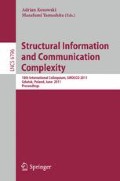Abstract
We are given a winding chain of n mobile robots between two stations in the plane, each of them having a limited viewing range. It is only guaranteed that each robot can see its two neighbors in the chain. The goal is to let the robots converge to the line between the stations. We use a discrete and synchronous time model, but we restrict the movement of each mobile robot to a distance of δ in each round. This restriction fills the gap between the previously used discrete time model with an unbounded step length and the continuous time model which was introduced in [1]. We adapt the strategy by Dynia et al. [2]: In each round, each robot first observes the positions of its neighbors and then moves towards the midpoint between them until it reaches the point or has moved a distance of δ. The main energy consumers in this scenario are the number observations of positions of neighbors, which equals the number of rounds, and the distance to be traveled by the robots. We analyze the strategy with respect to both quality measures and provide asymptotically tight bounds. We show that the best choice for δ for this strategy is \(\delta \in \Theta(\frac{1}{n})\), since this minimizes (up to constant factors) both energy consumers, the number of rounds as well as the maximum traveled distance, at the same time.
Partially supported by the EU within FP7-ICT-2007-1 under contract no. 215270 (FRONTS) and DFG-project “Smart Teams” within the SPP 1183 “Organic Computing” and International Graduate School Dynamic Intelligent Systems.
Access this chapter
Tax calculation will be finalised at checkout
Purchases are for personal use only
Preview
Unable to display preview. Download preview PDF.
References
Degener, B., Kempkes, B., Kling, P., Meyer auf der Heide, F.: A continuous, local strategy for constructing a short chain of mobile robots. In: Patt-Shamir, B., Ekim, T. (eds.) SIROCCO 2010. LNCS, vol. 6058, pp. 168–182. Springer, Heidelberg (2010)
Dynia, M., Kutylowski, J., Lorek, P.: Meyer auf der Heide, F.: Maintaining communication between an explorer and a base station. In: IFIP 19th World Computer Congress, TC10: 1st IFIP International Conference on Biologically Inspired Computing, pp. 137–146 (2006)
Kling, P.: Unifying the Analysis of Communication Chain Strategies. Master’s thesis, University of Paderborn, masters thesis (2010)
Kutylowski, J.: Using Mobile Relays for Ensuring Connectivity in Sparse Networks. Dissertation, International Graduate School of Dynamic Intelligent Systems (2007)
Dynia, M., Kutyłowski, J., Meyer auf der Heide, F., Schrieb, J.: Local strategies for maintaining a chain of relay stations between an explorer and a base station. In: SPAA 2007: Proc. of the 19th annual ACM symposium on Parallel algorithms and architectures, pp. 260–269 (2007)
Kutyłowski, J., Meyer auf der Heide, F.: Optimal strategies for maintaining a chain of relays between an explorer and a base camp. Theoretical Computer Science 410(36), 3391–3405 (2009)
Ando, H., Suzuki, Y., Yamashita, M.: Formation agreement problems for synchronous mobile robotswith limited visibility. In: Proc. IEEE Syp. of Intelligent Control, pp. 453–460 (1995)
Cohen, R., Peleg, D.: Convergence properties of the gravitational algorithm in asynchronous robot systems. SIAM Journal on Computing 34(6), 1516–1528 (2005)
Dieudonné, Y., Petit, F.: Self-stabilizing deterministic gathering. In: Algorithmic Aspects of Wireless Sensor Networks, pp. 230–241 (2009)
Souissi, S., Défago, X., Yamashita, M.: Gathering asynchronous mobile robots with inaccurate compasses. Principles of Distributed Systems, 333–349 (2006)
Izumi, T., Katayama, Y., Inuzuka, N., Wada, K.: Gathering autonomous mobile robots with dynamic compasses: An optimal result. Distributed Computing, 298–312 (2007)
Prencipe, G.: Impossibility of gathering by a set of autonomous mobile robots. Theoretical Computer Science 384(2-3), 222–231 (2007); Structural Information and Communication Complexity (SIROCCO 2005)
Agmon, N., Peleg, D.: Fault-tolerant gathering algorithms for autonomous mobile robots. In: SODA 2004: Proc. of the 15th annual ACM-SIAM symposium on Discrete algorithms, pp. 1070–1078 (2004)
Défago, X., Konagaya, A.: Circle formation for oblivious anonymous mobile robots with no common sense of orientation. In: International Workshop on Principles of Mobile Computing, POMC, pp. 97–104 (2002)
Chatzigiannakis, I., Markou, M., Nikoletseas, S.: Distributed circle formation for anonymous oblivious robots. In: Ribeiro, C.C., Martins, S.L. (eds.) WEA 2004. LNCS, vol. 3059, pp. 159–174. Springer, Heidelberg (2004)
Degener, B., Kempkes, B., Meyer auf der Heide, F.: A local O(n 2) gathering algorithm. In: SPAA 2010: Proc. of the 22nd ACM symposium on parallelism in algorithms and architectures, pp. 217–223 (2010)
Degener, B., Kempkes, B., Langner, T., auf der Heide, F.M., Pietrzyk, P., Wattenhofer, R.: A tight runtime bound for synchronous gathering of autonomous robots with limited visibility. In: SPAA 2011: Proc. of the 23rd annual ACM symposium on parallel algorithms and architectures (accepted for publication)
Ando, H., Oasa, Y., Suzuki, I., Yamashita, M.: Distributed memoryless point convergence algorithm for mobile robots with limited visibility. IEEE Transactions on Robotics and Automation 15(5), 818–828 (1999)
Brandes, P., Degener, B., Kempkes, B., auf der Heide, F.M.: Energy-efficient strategies for building short chains of mobile robots locally (2011), http://wwwhni.uni-paderborn.de/alg/publikationen
Cohen, R., Peleg, D.: Robot convergence via center-of-gravity algorithms. In: Kralovic, R., Sýkora, O. (eds.) SIROCCO 2004. LNCS, vol. 3104, pp. 79–88. Springer, Heidelberg (2004)
Author information
Authors and Affiliations
Editor information
Editors and Affiliations
Rights and permissions
Copyright information
© 2011 Springer-Verlag Berlin Heidelberg
About this paper
Cite this paper
Brandes, P., Degener, B., Kempkes, B., Meyer auf der Heide, F. (2011). Energy-Efficient Strategies for Building Short Chains of Mobile Robots Locally. In: Kosowski, A., Yamashita, M. (eds) Structural Information and Communication Complexity. SIROCCO 2011. Lecture Notes in Computer Science, vol 6796. Springer, Berlin, Heidelberg. https://doi.org/10.1007/978-3-642-22212-2_13
Download citation
DOI: https://doi.org/10.1007/978-3-642-22212-2_13
Publisher Name: Springer, Berlin, Heidelberg
Print ISBN: 978-3-642-22211-5
Online ISBN: 978-3-642-22212-2
eBook Packages: Computer ScienceComputer Science (R0)

